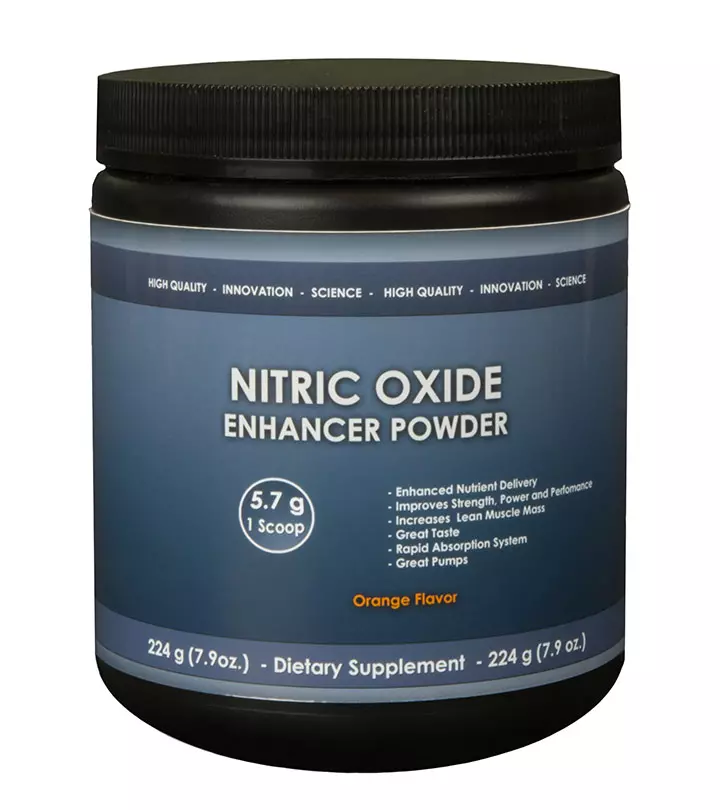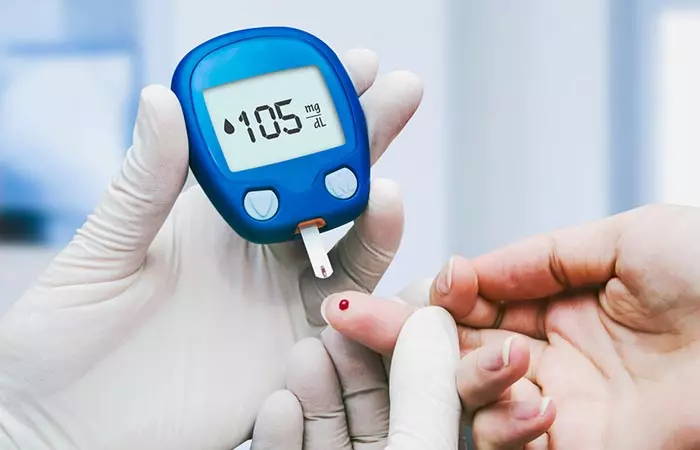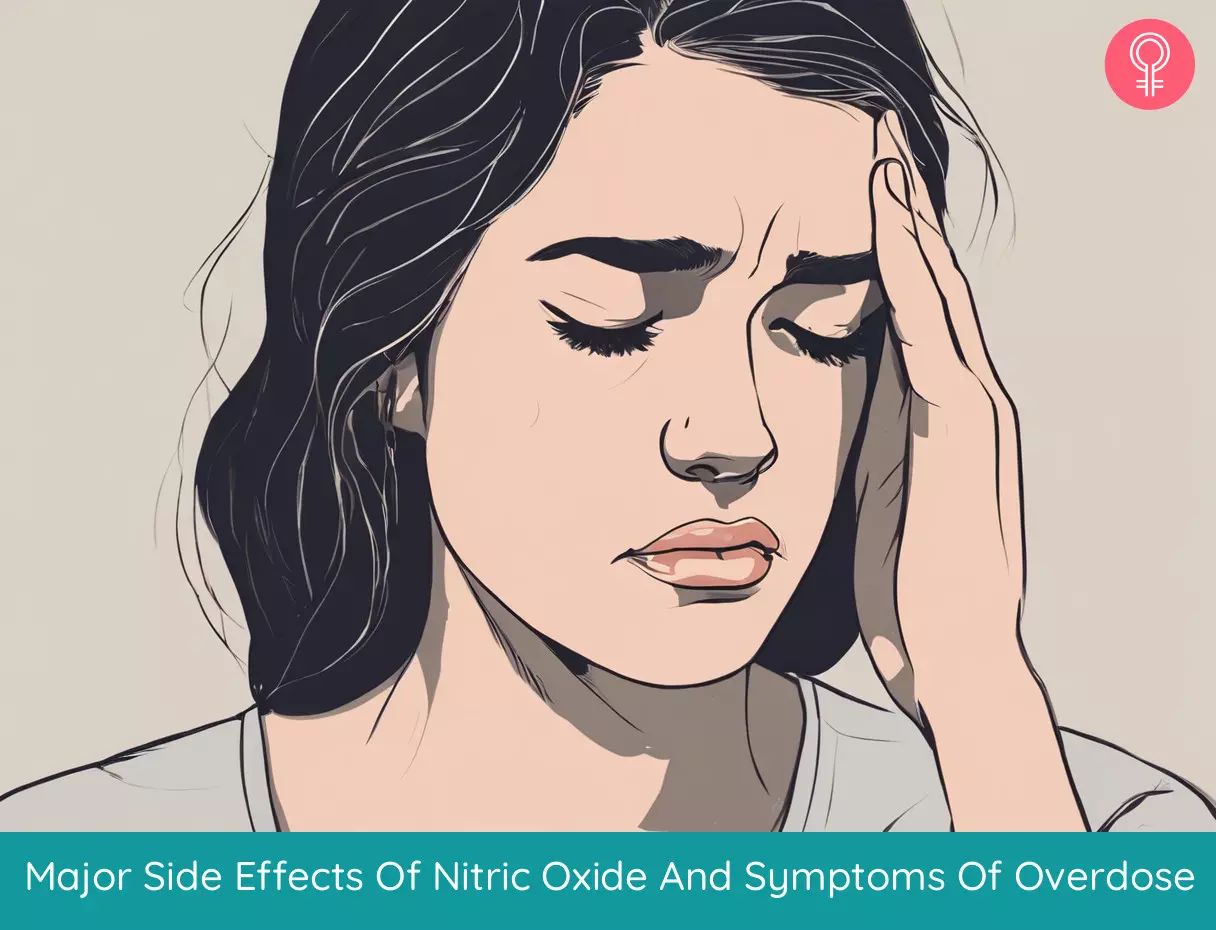9 Major Side Effects Of Nitric Oxide And Symptoms Of Overdose
Learn about the other side of the coin before taking these supplements.

Image: shutter stock
It is vital to be aware of the potential side effects of nitric oxide inhalation. Nitric oxide plays a vital role as a signaling molecule to communicate properly. The discovery of nitric oxide’s role in cardiovascular health got the researchers the much-coveted Nobel Prize (1).
This gas influences blood flow, breathing, hemostasis (prevention of bleeding), neurotransmissioni Communication by chemicals, called neurotransmitters, from neurons to muscles or between different neurons. , and the immune system (2). However, inhaling nitric oxide can have systemic effects, leading to dizziness or lightheadedness. In addition, the respiratory tracts, the skin, and the eyes may be irritated.
Nitric oxide is a volatile gas, and as soon as it comes into contact with air, it transforms into nitrogen dioxide.
This article examines the side effects of nitric oxide, the symptoms it produces, its safety, and the recommended dosage. Take a look below.
 Know The Flip Side: Nitric Oxide
Know The Flip Side: Nitric OxideShort-Term Effects
Dizziness, confusion, headache, fatigue, blurred vision, labored breathing, diarrhea, irregular heartbeat, irritation of the skin and eyes.
Long-Term Effects
Blindness, weakened immune system, memory loss, brain and nerve damage, limb spasms, birth defects in the offspring, reproductive system damage, depression, and psychosis.
Drug Interactions
Interacts with anesthetics, psychoactive drugs, and alcohol, and amplifies their effects.
When To See A Doctor
Since these are subscription supplements, consult a doctor at the first signs of any discomfort.
Side Effects Of Nitric Oxide
Nitric oxide inhalation can cause confusion, headache, fatigue, sweating, and lethargy (3). Let us discuss the more common side effects of nitric oxide in detail.
1. May Cause Blurred Vision

High concentrations of nitric oxide can cause irritation in the eyes. Prolonged exposure can cause blurred vision. In extreme cases, it may even cause blindness (4).
 Trivia
Trivia2. May Cause Respiratory Ailments
Even low concentrations of nitric oxide can irritate the lungs and the respiratory tract. The initial symptoms of nitric oxide inhalation include cough and difficulty with breathing. Prolonged exposure can cause spasms in the lungs and pulmonary edema (5).
Inhaled nitric oxide, in higher concentrations, can be quite fatal. Symptoms may include burns, airway obstruction due to swelling of tissues, respiratory distress, and even death.
Elevated levels of endogenous nitric oxide in cells is a sign of oxidative stress. Though the status of NO has not been established, there have been reports stating that NO could be involved in acute lung injury (6).
The effects of nitric oxide on adult lung disease are unclear (7).
3. May Have Hematologic Effects
Patients with sepsis have a higher risk of side effects due to nitric oxide. The bodies of such patients release large quantities of nitric oxide. The NO is converted to methemoglobin and nitrate, eventually resulting in methemoglobinemia (8).
Methemoglobinemia is a condition in which the iron in hemoglobin is oxidized. This impairs oxygen transport and leads to cyanosis (a condition characterized by inadequate oxygen in the blood, also known as hypoxia) (8).
4. May Lead To Metabolic Disorders

Higher concentrations of nitric oxide are associated with metabolic disorders, such as diabetes and cardiovascular disease (9). Patients with hyperglycemia (or high blood sugar) have elevated levels of nitric oxide. Studies have linked high NO levels to endothelial dysfunction and cardiovascular disease (9).
5. May Cause Arterial Stiffness
Inhaled nitric oxide is a vasodilatori Drugs that dilate blood vessels and allow the body's various organs to receive more blood. and can modulate blood pressure. Impaired nitric oxide has been associated with arterial stiffness, a major cause of hypertension (10). High blood pressure can cause pulmonary hypertension, where blood flow in the blood vessels is impaired. This increases the risk of other metabolic disorders, such as diabetes and heart failure (10).
6. May Cause Nausea, Vomiting, And Diarrhea

Overdose of nitric oxide supplements can cause stomach problems, like diarrhea, nausea, and vomiting. It can cause gastric burns in extreme cases (11).
7. May Cause Vasodilation And Bleeding
Nitric oxide can disrupt pulmonary circulation. It can cause excessive bleeding and low blood pressure. Those on heart medications should consult their physician before using nitric oxide products.
Nitric oxide synthase inhibits bleeding time. Overdose of NO may also cause side effects associated with the kidneys, including blood in the urine (hematuria) (12).
8. May Cause Cardiovascular Issues

Inhaling nitric oxide can be fatal to heart health. The role of nitric oxide as a vasodilatori Drugs that dilate blood vessels and allow the body's various organs to receive more blood. has been extensively studied. However, it may cause adverse effects, such as reduced pulse, dilated heart, and cardiac dysfunction (13). Research has also found that elevated levels of NO can lead to cardiac failure (14).
9. May Cause Electrolyte Imbalance
Excess nitric oxide in the body can lead to high levels of creatinine and urea (15). This may be particularly harmful to people with liver or kidney disorders as it may hinder the blood purification process. In severe cases, it can lead to liver damage or renal failure too.
These are some of the side effects of nitric oxide. It may also lead to other side effects like sepsis, infection, dyspneai Uncomfortable breathing or a feeling of not getting enough air into your lungs due to tightening of the chest. , cellulitis, and headaches (16).
Keep reading to know the symptoms of nitric oxide overdose.
Symptoms Of Overdose
Exposure to high levels of nitric oxide may elicit an immediate response, such as abdominal pain, headache, heartburn, palpitations, nausea, vomiting, bloating, and diarrhea. Sometimes, there are no symptoms for 24 hours. After that, symptoms such as lethargy, confusion, anxiety, swelling in the lungs, or loss of consciousness have been observed (11).
As per anecdotal evidence, other symptoms of overdose could be dark-colored urine, rapid heartbeat, fever, headaches, sore throat, unusual bleeding, or bruising. The skin might turn pale and other parts, such as the lips and fingernails, may turn blue.
Thus, it is important to talk to a healthcare professional before starting nitric oxide supplementation. They can help you figure out the appropriate dosage for your needs, especially if you have any health problems or take medications.
What Is A High Nitric Oxide Level?
The legal limit for NO occupational exposure is 25 parts per million (ppm). Anything higher than that can be toxic (17).
How Much Nitric Oxide Should You Take?

The recommended dose is 20 ppm. Our cells are capable of producing endogenous nitric oxide to suit the requirements of the body. However, you can add NO naturally by consuming nitrate rich vegetables, such as lettuce, celery, beetroot, and spinach.
Consuming vitamins and antioxidants, such as vitamin C and glutathione, also helps in boosting NO levels in the body. Consuming oral supplements, such as L-Arginine and L-citrulline, also increases NO.
 Trivia
TriviaAs you are familiar with the side effects of excess nitric oxide, it is advisable not to incorporate extra NO without medical supervision.
Infographic: Everything About Nitric Oxide
Nitric oxide can prove to be harmful if taken in large quantities. However, under moderate consumption, it can help address several health issues. Nitric oxide supplements or their precursor, L-citrulline, can help dilate your blood vessels and allow nutrients to travel effectively.
Discover nitric oxide, how it may help, and its short-term and long-term side effects in the infographic below. Illustration: StyleCraze Design Team
Nitric oxide plays a key role in cardiovascular health. This volatile gas also helps in improving immune health and has many therapeutic applications. However, excess inhalation of nitric oxide may cause side effects. It may cause blurred vision, respiratory problems, and hematologic (diseases related to blood) effects and increase the risk of metabolic disorders like type 2 diabetes and cardiovascular disease. In addition, it may cause nausea, vomiting, diarrhea, vasodilationi A natural process that widens and relaxes blood vessels to increase blood flow to parts of the body deficient in oxygen or nutrients. , and bleeding. While some of these symptoms are immediate, some may take 24 hours to show. Children are mostly affected by nitric oxide due to their lower body weight. If you experience any symptoms after nitric oxide inhalation, consult your doctor immediately.
Frequently Asked Questions
Can nitric oxide supplements cause any long-term effects?
Yes. While short-term use may be generally safe, prolonged use can lead to side effects or overdose symptoms such as headaches, low blood pressure, and digestive issues (11). So, consult with a healthcare professional before starting any nitric oxide supplementation to assess individual risks and benefits.
Does nitric oxide cause brain damage?
Research on the role of nitric oxide on the brain is not clear. More studies are warranted to understand the role of nitric oxide in this aspect.
How do you test for nitric oxide levels?
There are specific medical tests available. Diagnostic tools such as pH strips can also be used to test for nitric oxide levels.
Does nitric oxide cause muscle pain?
There is currently very little research on the effect of nitric oxide on muscle soreness. A study suggests that nitric oxide may activate certain receptors that cause a pain sensation (18). However, further studies are needed to understand the effect of nitric oxide on muscle soreness.
Does nitric oxide increase urination?
According to research, inhaling nitric oxide can directly increase the volume of urination (19). However, more studies are required to understand the effect of nitric oxide intake in the form of a supplement.
Key Takeaways
- Avoid inhaling nitric oxide as it may cause dizziness and breathing issues.
- It may blur your vision and may lead to acute lung injury and metabolic disorders.
- If you inhale it, your blood pressure may get affected, leading to heart failure.
- The recommended dosage of nitric oxide is 20 ppm.
Illustration: Major Side Effects Of Nitric Oxide And Symptoms Of Overdose

Image: Stable Diffusion/StyleCraze Design Team
References
Articles on StyleCraze are backed by verified information from peer-reviewed and academic research papers, reputed organizations, research institutions, and medical associations to ensure accuracy and relevance. Read our editorial policy to learn more.
- Ignarro, Louis J. “Nitric oxide: A unique endogenous signaling molecule in vascular biology (Nobel lecture).” Angewandte Chemie International Edition 38.13‐14 (1999): 1882-1892.
https://onlinelibrary.wiley.com/doi/abs/10.1002/(SICI)1521-3773(19990712)38:13/14%3C1882::AID-ANIE1882%3E3.0.CO;2-V - Divakaran, Sanjay, and Joseph Loscalzo. “The role of nitroglycerin and other nitrogen oxides in cardiovascular therapeutics.” Journal of the American College of Cardiology 70.19 (2017): 2393-2410.
https://www.ncbi.nlm.nih.gov/pmc/articles/PMC5687289/ - Divakaran, Sanjay, and Joseph Loscalzo. “The role of nitroglycerin and other nitrogen oxides in cardiovascular therapeutics.” Journal of the American College of Cardiology 70.19 (2017): 2393-2410.
https://www.ncbi.nlm.nih.gov/pmc/articles/PMC5687289/ - “Erdinest N, London N, Ovadia H, Levinger N. Nitric Oxide Interaction with the Eye. Vision (Basel). 2021 Jun 9;5(2):29. doi: 10.3390/vision,
https://www.ncbi.nlm.nih.gov/pmc/articles/PMC8293394/ - “Preston IR, Klinger JR, Houtchens J, Nelson D, Mehta S, Hill NS. Pulmonary edema caused by inhaled nitric oxide therapy in two patients with pulmonary hypertension associated with the CREST syndrome. Chest. 2002 Feb;121(2):656-9,
https://pubmed.ncbi.nlm.nih.gov/11834688/ - Van der Vliet, Albert, Jason P. Eiserich, and Carroll E. Cross. “Nitric oxide: a pro-inflammatory mediator in lung disease?.” Respiratory research 1.2 (2000): 1.
https://respiratory-research.biomedcentral.com/articles/10.1186/rr14 - Hart, C. Michael. “Nitric oxide in adult lung disease.” Chest 115.5 (1999): 1407-1417.
https://pubmed.ncbi.nlm.nih.gov/10334161/ - Rehman, Habib Ur. “Evidence-based case review: methemoglobinemia.” Western Journal of Medicine 175.3 (2001): 193.
https://www.ncbi.nlm.nih.gov/pmc/articles/PMC1071541/ - Adela, Ramu, et al. “Hyperglycaemia enhances nitric oxide production in diabetes: a study from South Indian patients.” PloS one 10.4 (2015).
https://www.ncbi.nlm.nih.gov/pmc/articles/PMC4403926/ - Hermann, Matthias, Andreas Flammer, and Thomas F. Lüscher. “Nitric oxide in hypertension.” The Journal of Clinical Hypertension 8 (2006): 17-29.
https://pubmed.ncbi.nlm.nih.gov/17170603/// - Kiani AK, Bonetti G, Medori MC, et al. 2022 Oct 17;63(2 Suppl 3):E239-E245. doi: 10.15167/2421-4248/jpmh2022.63.2S3.2766.
https://www.ncbi.nlm.nih.gov/pmc/articles/PMC9710401/ - Reddy, Y. S., et al. “Nitric oxide status in patients with chronic kidney disease.” Indian journal of nephrology 25.5 (2015): 287.
https://www.ncbi.nlm.nih.gov/pmc/articles/PMC4588324/ - Cotton, J. M., M. T. Kearney, and A. M. Shah. “Nitric oxide and myocardial function in heart failure: friend or foe?.” Heart 88.6 (2002): 564.
https://www.ncbi.nlm.nih.gov/pmc/articles/PMC1767463/ - Macdonald, Peter, Christopher Schyvens, and David Winlaw. “The role of nitric oxide in heart failure.” Drugs & aging 8.6 (1996): 452-458.
https://pubmed.ncbi.nlm.nih.gov/8736629// - Meenakshi, S. R., and Rajni Agarwal. “Nitric oxide levels in patients with chronic renal disease.” Journal of clinical and diagnostic research: JCDR 7.7 (2013): 1288.
https://www.ncbi.nlm.nih.gov/pmc/articles/PMC3749617/ - Hierholzer, C., and T. R. Billiar. “Nitric oxide in trauma and sepsis.” Surgical Treatment: Evidence-Based and Problem-Oriented. Zuckschwerdt, 2001.
https://www.ncbi.nlm.nih.gov/books/NBK6909/ - Stavert, D. M., and B. E. Lehnert. “Nitric oxide and nitrogen dioxide as inducers of acute pulmonary injury when inhaled at relatively high concentrations for brief periods.” Inhalation Toxicology 2.1 (1990): 53-67.
https://www.tandfonline.com/doi/abs/10.3109/08958379009145245 - Radak, Zsolt et al. “Nitric oxide: is it the cause of muscle soreness?.” Nitric oxide : biology and chemistry vol. 26,2 (2012): 89-94.
https://pubmed.ncbi.nlm.nih.gov/22227257/ - Wraight, W. M., and J. D. Young. “Renal effects of inhaled nitric oxide in humans.” British journal of anaesthesia 86.2 (2001): 267-269.
https://academic.oup.com/bja/article/86/2/267/277831
Read full bio of Nilofar Pendhari
Read full bio of Ravi Teja Tadimalla
Read full bio of Arshiya Syeda
Read full bio of Sindhu Koganti


























Community Experiences
Join the conversation and become a part of our empowering community! Share your stories, experiences, and insights to connect with other beauty, lifestyle, and health enthusiasts.